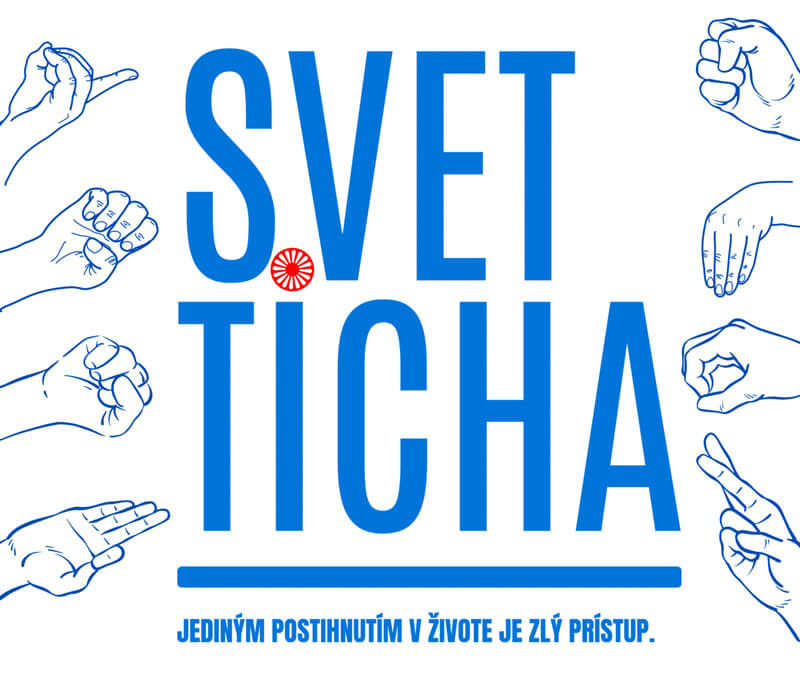Deaf Roma are part of two minorities that face different challenges – the Roma community and the deaf world. How to help them not to be marginalized? How to overcome language barriers and open the door to education and self-realization? These questions were the core of the workshops “Together we create a community of deaf Roma”, which took us to several cities and towns in Slovakia.
During our trip, we visited the villages of Veľký Šariš, Svinia, the city of Prešov, where we attended a three-day workshop in Jarovnice at the Youth Center, met with communities, Abranovce, Žehn, Čelovce, Košice (Luník IX.) and Ostrovany.
Jarovnice: Three days full of inspiration
An intensive three-day series of workshops took place at the Youth Center in Jarovnice, where we met with young Roma who are interested in personal development and a better understanding of the world of the deaf. The program was dynamic – from interactive lectures, through practical demonstrations of sign language, to discussions in which we realized how important understanding and empathy are.
Many young people tried communicating in sign language for the first time and realized that deaf Roma often do not have access to information that is taken for granted by others.
Elementary school in Prešov: Sign language as a key
At the Forestry School in Prešov, we met with students who were interested in how to communicate with deaf classmates and how to facilitate their integration into the school environment. We showed each other basic signs and situations in which it is important to react correctly.
The students tried out simple sign dialogues and understood that even a small effort can create a bridge between the world of hearing and deaf people.
Stories from the field
We also visited community centers for field social workers (TSP) in the villages of Svinia, Abranovce, Žehn and Čelovce, where we discussed with frontline workers. These people are in daily contact with Roma communities and know their problems firsthand.
Together we analyzed the main barriers that deaf Roma encounter and looked for solutions. Many TSPs agreed that there is a lack of sign language interpreters in the communities, which is why deaf children and adults often remain isolated.
Luník IX., Ostrovany: Elementary schools as a place of change
A very important part of our trip were also visits to elementary schools ZŠ na Luník IX. in Košice and ZŠ in Ostrovany, it is the school that is the place where real change can begin.
Teachers and students tried out the basics of sign language, learned more about the needs of deaf Roma and discussed how they can help them integrate into the school community. For many, it was a new experience that opened their eyes.
When you can neither see nor hear the world: Visit to a school for children with combined disabilities in Červenica
One of the most significant moments of the entire series of workshops was the visit to the Special School for Children with Combined Disabilities in Červenica. This school is the only facility of its kind in Slovakia dedicated to the education of children with combined hearing and visual impairments.
Our visit brought a new perspective on communication in conditions where regular sign language may not be sufficient. Teachers in Červenica use special haptic methods, tactile signing and individually adapted educational approaches. Deaf Roma children who study here face a triple barrier – linguistic, sensory and social.
It was fascinating to see how, despite these challenges, children learn, express emotions and communicate using touch and alternative forms of sign language. This visit showed us that even in the most challenging conditions there are paths to education and self-realization, if supported by the right approach.
One of the strongest moments of our visit to the Special School for Children with Combined Disabilities in Červenica was a conversation with teachers who work daily with children for whom the world of sounds and images is limited.
One of the teachers told us:
“Combined disability is not just about hearing and sight loss. It is about the loss of the ability to be understood. Our task is to find ways to communicate with these children, to give them the tools to express their thoughts and feelings. Every child has their own way of perceiving the world – we must learn to understand it.”
This quote perfectly captures the essence of our journey – to understand, respect and create conditions in which everyone can find their voice, even if they cannot hear or see it.
What did we take away?
The weeks spent in the workshops showed us one important thing – a common path to understanding exists, but we must walk it together.
Deaf Roma need linguistic and social support, but the awareness of the majority is equally important. And it is workshops like these that help break down barriers, dismantle prejudices, and create a more open and inclusive society.
We create a community together – not in words, but in actions.






